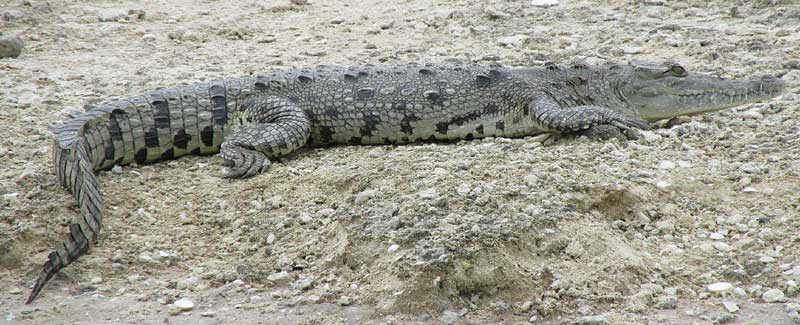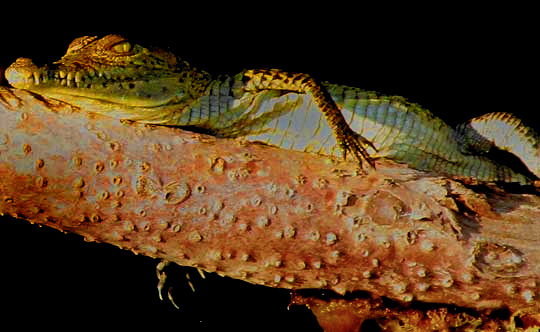Excerpts from Jim Conrad's
Naturalist Newsletter

from the November 9, 2014 Newsletter issued from Río Lagartos, on the Yucatan Peninsula's northern coast (~N21.60°, ~W88.16°), Yucatán state, MÉXICO
AMERICAN CROCODILE
In last week's Newsletter when we looked at the Morelet's Crocodile commonly seen in the estuary around Río Lagartos, I remarked that so far all the crocodiles I've seen here appeared to be Morelet's. This week while among the vast network of evaporation ponds where salt is commercially harvested near Las Coloradas about 30 kms east of Río Lagartos, my first American Crocodile, CROCODYLUS ACUTUS, turned up. You can see him above, on salt-encrusted ground beside a ditch filled with saltwater, just across small dunes from waters of the Gulf of Mexico.
A close-up of his head is shown below:

One obvious distinction between the American Crocodile and the Morelet's is that the American's snout is narrower. If you have a picture of the head from above, here's how you can determine mathematically whether the snout is "narrow": Keeping in mind that "maxillary teeth" are those arising in the upper jaw, they're numbered from the front, and that the tenth maxillary tooth coincides with the snout's constriction about midway the snout's length, Jonathan Campbell in Amphibians and Reptiles of Northern Guatemala, the Yucatán, and Belize tells us the following:
The American Crocodile's snout width at the tenth maxillary tooth is less than or equal to 70% of the distance from the base of the tenth maxillary tooth to the tip of the snout. In contrast, the Morelet's snout is wider -- at the tenth maxillary tooth the snout's width is greater than or equal to 75% of the distance from the base of the tenth maxillary tooth to the tip of the snout.
The problem is that in the field normally you don't get a good view from above the head. Still, a side view such as the above photos show also is useful, especially when comparing them with diagrams at the Crocodilian.Com website.
That website's head diagram for the American Crocodile {used to be} at http://crocodilian.com/cnhc/cst_cacu_am_head.htm.
The corresponding diagram for the Morelet's Crocodile's head {used to be} at http://crocodilian.com/cnhc/cst_cmor_am_head.htm.
Comparing our pictures with those diagrams we can see that the upper jaw of our salt-flat croc lacks a low mound before the eyes. Also, at its end the snout is considerably more slender than the Morelet's. Therefore, this new sighting is a good example of the American Crocodile.
You might also like to compare these American Crocodile pictures with those on our Morelet's page at www.backyardnature.net/yucatan/morecroc.htm.
Despite this being my first definite sighting of an American Crocodile, I wasn't too surprised, since the windswept, flat, sun-glaring, salt-encrusted flats next to the Gulf of Mexico constituted a very different habitat from the dark-water ponds, backwaters and slow-moving, mangrove-protected spots where before now I've found nothing but Morelet's Crocodiles.
Maybe the easiest way to distinguish the two species is that on the American Crocodile's belly the scales form regular ranks and files of rectangular scales, while the Morelet's belly scales have smaller scales interspersed among larger ones, disrupting the systematic pattern. In the field, however, you don't see these features.
Yet another feature possibly distinguishing the two crocodile species is that this American Crocodile didn't let us get nearly as close as the Morelet's normally does. Local guides always say that the American is "más bravo" than the Morelet's -- hotter tempered.
All this being said, in my opinion, in the field, during most spottings when mainly you get a side view of just the top of the crocodile emerged, it's hard to tell the two species apart. But if you're in seawater or among the salt ponds, it's almost certainly the American Crocodile.
from the January 25, 2015 Newsletter issued from Río Lagartos, on the Yucatan Peninsula's northern coast (~N21.60°, ~W88.16°), Yucatán state, MÉXICO
A CONTENTED-LOOKING BABY CROCODILE
The other day on a Red Mangrove snag issuing from the estuary's water a young crocodile only about ten inches long basked in late afternoon sunlight looking so comfortable and contented that I had to take a picture, which is shown below:

Judging from the very regular pattern of scaling on the critter's bottom, I'd say that this is an American Crocodile. On our other species, the Morelet's, the pattern is disrupted by scales appearing between otherwise straight ranks and files of belly scales.